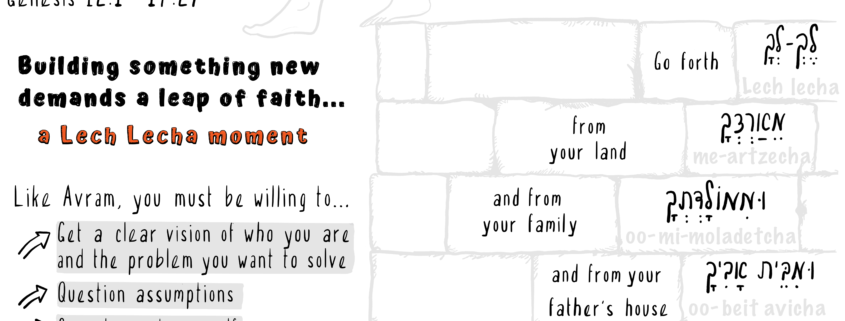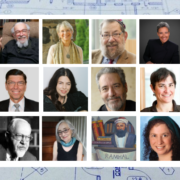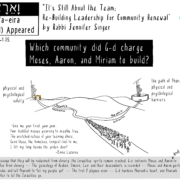Four Building Lessons in Avram’s Lech Lecha Call
Part of a yearlong series about building and builders inspired by the Torah cycle.

Building something demands a leap of faith. Proto-ancestor Avram shows us the kind of leap, and the kind of faith, that wise building requires.
וַיֹּ֤אמֶר יהו׳׳ה אֶל־אַבְרָ֔ם לֶךְ־לְךָ֛ מֵאַרְצְךָ֥ וּמִמּֽוֹלַדְתְּךָ֖ וּמִבֵּ֣ית אָבִ֑יךָ אֶל־הָאָ֖רֶץ אֲשֶׁ֥ר אַרְאֶֽךָּ׃
YHVH said to Avram, “Lech-lecha / Go forth from your land, and from your birth,
and from your father’s house, to the land that I will show you. (Genesis 12:1).
When I left Colorado two years ago to return to the east coast, I experienced a Lech Lecha (“Go forth!”) moment of venturing into the unknown. I left behind the familiarity of a legacy institution, and set out into the unknown world of the start-up rabbinate. Though I had general outlines of the kind of community I wanted to build, my path was mostly a mystery. The leap I took felt like jumping off a tall cliff and building an airplane on the way down.
Building something new demands this sort of leap.
Avram, who later took the name Avraham, had to take a far greater leap of faith into the unknown to build the family that would become the Israelite People. That’s why Avram is our spiritual ancestor in more ways than one: Avram is not only regarded as the first monotheist, but also he’s a spiritual entrepreneur – a builder par excellence.
God’s call to Avram begins with the phrase “lech lecha”. Many commentators remarked on the superfluous nature of this grammatical construction. All Torah needs to say is lech (“go”). Instead, Torah says “lech lecha” (“go to you/for you”). Medieval commentator Rashi reads this seeming redundancy as evidence that God called Avram to go “for his own benefit, for his own good.” Zohar (thirteenth century) went farther, understanding lech lecha to mean “for your own sake: go away from here and rectify your soul, advancing your [spiritual] level.”
This is our first lesson that Avram’s Lech Lecha teaches about building:
- Builders need a clear vision of who they are, what they stand for, and what problems they want to solve.
To answer God’s call, Avram had to go deep into himself (as Rashi teaches), and do his own inner work to fix broken places in his soul (as Zohar teaches). All who follow in his footsteps must do the same. Once we know who we are and what we stand for, we’ll reach greater clarity about the problem we want to solve — or, to use our core metaphor, we’ll have a clearer sense of what and how we’re being called to build.
We need inner clarity so that we can see what’s outside us more clearly. Otherwise our own stuff is likely to cloud our vision, so that what we see becomes a reflection of ourselves, rather than a clear lens on the work at hand. And we need to keep doing our inner work so that we can boldly and wisely “go forth” into places we can’t yet know.
- Builders must question unconscious assumptions encoded in their origins.
The next part of Avram’s call instructs him to go me-artzecha (“from your land”). We can read this phrase literally that Avram had to leave his country of origin, which was true. We also can read it to mean that one must leave behind preconceived notions about how the world works and what’s possible. Everyone has unconscious assumptions, and those assumptions aren’t necessarily bad or wrong, but often they reflect the past (what has been) – not the potential (what can be) or the future (what will be). To most wisely build the Jewish future, we all must notice our assumptions and their origins, and be willing to risk them. Only then can we be sure to build the future on its own terms, rather than merely replicating or responding to the past.
- Builders must grow beyond preconceived capacities both individually and together.
The third part of Avram’s Lech Lecha calls him mi-moladetcha – usually translated “from your birthplace” but also from one’s inherent birth-self. Our predisposed talents and capacities are important to know for all they are: not everyone is born with native inclination or capacity to be an engineer, or designer, or craftsperson. We’re all different and those differences are important to honor.
That said, Lech Lecha calls us beyond what we think we can do, because we often can do more than we think – and the future needs all we can give.
To best serve the future, wise builders must discern what they can learn to do better and how they can do better. Wise builders must continually develop a broader and deeper toolkit than perhaps they think possible. Just as Avram’s journey called him to become more resourceful, more outgoing, and probably also more organized than he was before, so for everyone who seek to build new structures to house the life of spirit.
And what we truly can’t do alone, we must do together. Avram didn’t go it alone: he brought helpers and made alliances along the way. Anyone who builds alone is likely to build only a house for one.
- Builders must be ready to leave behind outdated structures, however much beloved.
God’s final Lecha Lecha direction to Avram was to leave behind beit avicha (his “father’s house”). God encodes a building metaphor (and Bayit’s name!) to make a key point about building.
The key point is this: some structures must be left behind to build the future.
The idea of jettisoning the old may seem to contradict one of our keystone principles about backward compatibility – that when we build and innovate, most new structures shouldn’t so “break” with what came before that they lose their foundation. But these two ideals (backward compatibility and shedding past baggage) must be in fruitful relationship and dynamic tension.
Even when we leave behind past experiences, they continue to shape us. Indeed, when our hero wants to find a wife for his son Isaac, he sends his servant back to his country of origin, a sign that even though he “left home” long ago, he’s still shaped by where he came from.
Reb Zalman z”l, who spoke often about backward compatibility, also spoke of the need to drive using the wide view of the windshield, not only the limited perspective of a rearview mirror. Like Avram, we must keep looking back at where we came from – hopefully lovingly. And like Avram, we also must strike out in new directions. When old ideas no longer serve, we must claim permission to rebuild them, or build anew, to meet the needs of a new time. Often, though not always, tradition’s ancestral foundations will still serve. And we shouldn’t be afraid to re-use, remix, and re-purpose them.
Building the future is an exciting and often scary proposition. Sometimes building the future will be incremental and relatively conservative; sometimes it’ll seem like a radical break with what came before but stand on ancient foundations or even deeper bedrock. The Lech Lecha journey of building a new home asks clear vision, challenging assumptions, learning new tools and new ways, working together, sometimes leaving it all behind, and sometimes finding our way back.
It’s a dynamic, holy and ongoing journey. Just ask Avram, this week’s building teacher.


by Rabbi Ben Newman; sketchnote by Steve Silbert.









Trackbacks & Pingbacks
[…] Four Building Lessons in Avram’s Lech Lecha Call […]
Comments are closed.